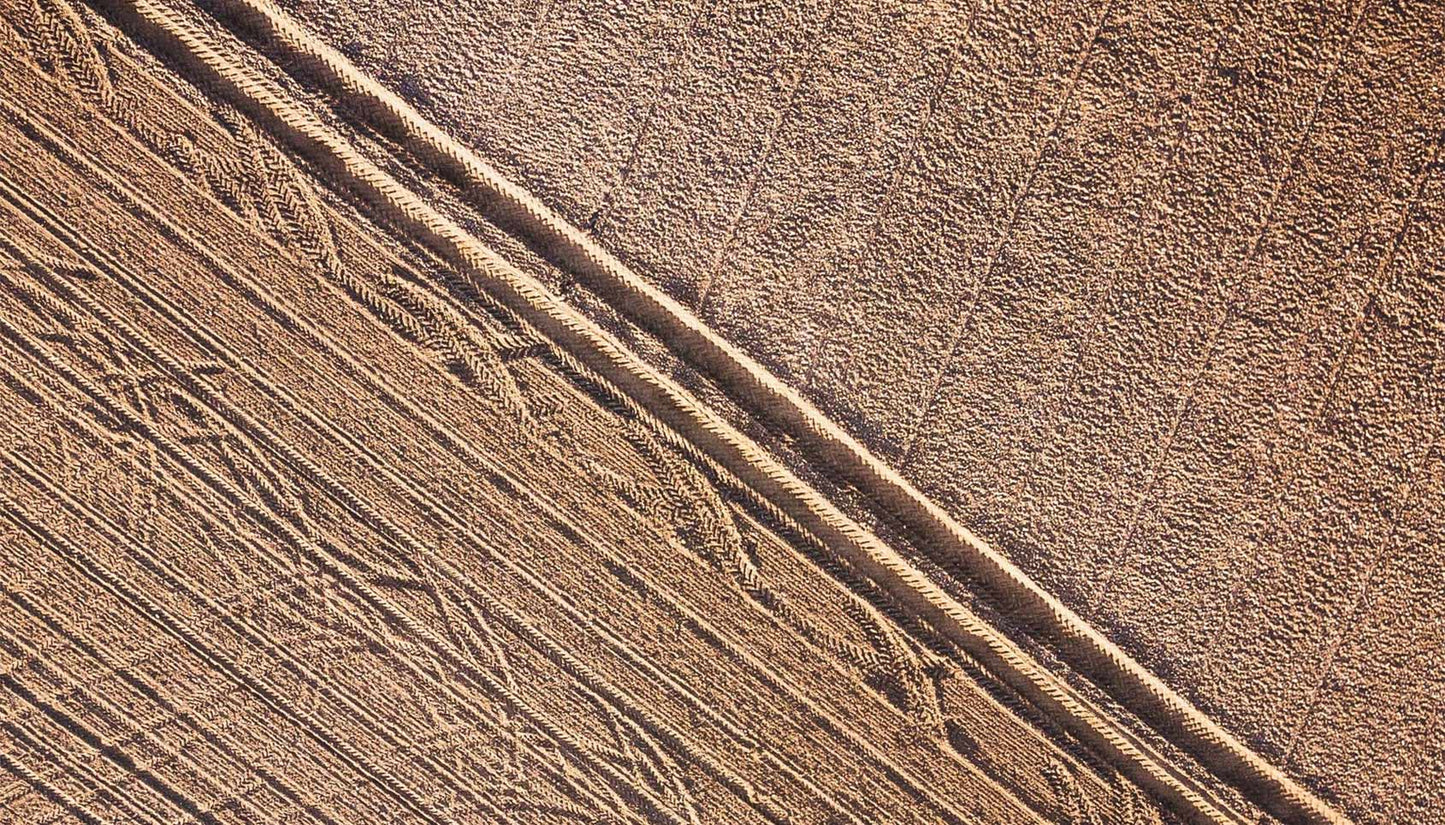We source our chicken from one farm in Leicestershire. The farm is Pasture for Life certified and rears truly free range, outdoor birds.

In response to the news article from the Guardian Tuesday 12th July
‘It’s a non-party political issue’: banning the weedkiller glyphosate
The WHO declared it a probable human carcinogen in 2015 and 70-80 UK councils have turned to chemical-free options. - Laura Laker
Glyphosate has become a very controversial compound in recent years and has been heavily discussed in the news recently. In this article we will do a bit of deep dive into what it is, where it came from and its benefits and problems.
Glyphosate is the active ingredient in a weedkiller (or herbicide) called Roundup but the interesting thing about it is that it started out with a very different use in mind. It was developed initially as a chelation agent meaning it can bind to metal ions and other inorganic compounds, it was originally used a cleaner for industrial piping, however, it was soon noted that where it was spilled on the earth everything died and in 1971 it was patented as a herbicide, and because it such a broad spectrum herbicide it was very very useful to agriculture.
Image shows the simple structure of the glyphosate

So why is a weedkiller so useful in agriculture?
Weedkillers or herbicides are incredibly useful to us as they give us the ability to kill off plants where and when we need to, this includes those destined for consumption. Examples of how glyphosate can be used is to control invasive species, to prepare ground for planting eradicating any weeds that will compete with crops as well as killing off a crop such as wheat before harvest, for this purpose glyphosate is considered to be a desiccant.
Glyphosate itself is not a chemical desiccant; rather glyphosate application just before harvest kills the crop plants so that the food crop dries from environmental conditions ("dry-down") more quickly and evenly allowing for better harvesting conditions.
Other uses for this compound include eradication of illicit crops such as coca and marijuana as well as preventing anything growing through pavements and roads.
How does it work?
Science bit coming.... Glyphosate interferes with the shikimate pathway, which produces the aromatic amino acids phenylalanine, tyrosine and tryptophan in plants and microorganisms, specifically it blocks this pathway by inhibiting the enzyme 5-enolpyruvylshikimate-3-phosphate synthase (EPSPS), which catalyses the reaction of shikimate-3-phosphate (S3P) and phosphoenolpyruvate to form 5-enolpyruvyl-shikimate-3-phosphate (EPSP).
Ok, enough...
Mammals, such as us, do not have the shikimate pathway in our metabolism, and hence the toxicity is considered to be relatively low in humans.
So what's the problem? Here we have a simple chemical with multiple uses in agriculture and keeps our roads and pavements free from weeds. Can spot kill invasive plants and kill illicit crops, sounds great right?
Monsanto scientists, after much trial and error, developed a genetic modification that meant that crops could be grown that are resistant to glyphosate.
In 1996, genetically modified soybeans were made commercially available.
Current glyphosate-resistant crops include soy, maize (corn), canola, alfalfa, sugar beets, and cotton, with wheat still under development. In 2015, 89% of corn, 94% of soybeans, and 89% of cotton produced in the United States were from strains that were genetically modified to be herbicide-tolerant.
What this means is that the farmer, as long as she / he buys the genetically modified seeds, can kill absolutely any other plant that might try to compete for nutrients with the crops. A crop can be sprayed with glyphosate and absolutely every other plant in that system is killed allowing for true mono-cropping.
The big but...
If anything sounds too good to be true, as the saying goes, it probably is. Glyphosate, while undoubtedly useful for conventional agriculture, has now been found to have a few rather large problems associated with its usage.
Soil is a living medium and glyphosate has an adverse effect on many of its inhabitants such as fungi, bacteria and even earthworms.
Soil experts, academics and scientific studies are also establishing clear links between the use of substances such as glyphosate with drops in soil fertility and the collapse of microbe ecosystems essential to healthy soil. Glyphosate can also predispose plants to diseases indirectly by reducing the overall growth and vigour of the plants, modifying soil microflora that affects the availability of nutrients required for disease resistance, and altering the physiological efficiency of plants.
Just because this substance doesn't directly affect the plants growing above the ground in the case of a roundup ready crop doesn't mean that potentially catastrophic damage is being done to the future productivity of the soil.
What about humans?
The first and most obvious effect on us is simply that the plants we consume for food have lower levels of nutrition when grown in glyphosate treated soils, this too is coupled with the astonishing lack of biodiversity both in our fields and on our plates but in recent times the direct safety of glyphosate for human health has been brought into question in an alarming way.
In March of 2015, IARC surveyed the published research on Roundup cancer links and concluded the blockbuster herbicide is “probably carcinogenic to humans.” The cancer agency further concluded that the cancer most associated with exposure to glyphosate is non-Hodgkin lymphoma.
Outraged by Monsanto’s deception, more than 100,000 people have made the decision to file a Roundup lawsuit alleging exposure to Roundup causes cancer.
Monsanto sold the herbicide to chemical giant Beyer in 2018 and Beyer knew that with the patent it was also buying a whole lot of expensive trouble linked to its usage. In an article in the New York Times in 2020 it reported that Company will make a total payment of $10.1 billion to $10.9 billion (EUR 9.1 billion to EUR 9.8 billion) to resolve current and address potential future Roundup™ litigation
What is staggering is that Beyer has decided to settle the multiple lawsuits relating to their product literally killing people but still continues to sell it without a warning on the label.
So how does it harm us if it only effects plant metabolism?
PMCID: PMC3945755
PMID: 24678255
Glyphosate, pathways to modern diseases II: Celiac sprue and gluten intolerance
Anthony Samsel1 and Stephanie Seneff
From the study listed above:
A recent study on glyphosate exposure in carnivorous fish revealed remarkable adverse effects throughout the digestive system (Senapati et al., 2009). The activity of protease, lipase, and amylase were all decreased in the esophagus, stomach, and intestine of these fish following exposure to glyphosate. The authors also observed “disruption of mucosal folds and disarray of microvilli structure” in the intestinal wall, along with an exaggerated secretion of mucin throughout the alimentary tract. These features are highly reminiscent of celiac disease. Gluten peptides in wheat are hydrophobic and therefore resistant to degradation by gastric, pancreatic and intestinal proteases (Hershko & Patz, 2008). Thus, the evidence from this effect on fish suggests that glyphosate may interfere with the breakdown of complex proteins in the human stomach, leaving larger fragments of wheat in the human gut that will then trigger an autoimmune response, leading to the defects in the lining of the small intestine that are characteristic of these fish exposed to glyphosate and of celiac patients.
In fact many researchers have hypothesised that the relatively recent rise in many autoimmune conditions are as a direct result of the effects of glyphosate on our gut bacteria. The gut microbiota that resides in the gastrointestinal tract provides essential health benefits to us, its host, particularly by regulating immune homeostasis. Moreover, it has recently become obvious that alterations of these gut microbial communities can cause immune dysregulation, leading to autoimmune disorders.
The legal fight
On Beyer's (the current patent holder) website it states categorically:
When it comes to safety assessments, glyphosate is among the most extensively tested pesticides on the market. Evaluations spanning more than 40 years, and the overwhelming conclusion of experts and regulators worldwide, support the safety of glyphosate and that glyphosate does not cause cancer.
However, this doesn't seem to have stopped them from paying out billions to claimants, the first notable one being Dewayne Johnson, a 46-year-old former groundskeeper. The jury determining that (then) Monsanto’s Roundup weedkiller caused his cancer and that the corporation failed to warn him of the health hazards from exposure. The jury further found that Monsanto “acted with malice or oppression” and ordered the settlement of some $289,000,000.
But it goes deeper and darker, Johnson's lawyer stated:
“We were finally able to show the jury the secret, internal Monsanto documents proving that Monsanto has known for decades that ... Roundup could cause cancer,” Johnson’s lawyer Brent Wisner said in a statement. The verdict, he added, sent a “message to Monsanto that its years of deception regarding Roundup is over and that they should put consumer safety first over profits”.
This landmark case in 2018 opened the door for further action agains the Monsanto starting a David and Goliath-esque battle that is still raging through the courts.
On the website https://www.lawsuit-information-center.com/
June 2022 Roundup Update
Roundup News Update June 30, 2022
Bayer loses again. The U.S. Supreme Court declined to hear a second Roundup verdict, this time the $87 million verdict for Alberta and Alva Pilliod. Bayer had a slightly different – albeit ridiculous – additional argument that the punitive damages award violated the U.S. Constitution.
The conventional wisdom is that Bayer will need to pay another $5 billion or more to settle the remaining outstanding 30,000 Roundup lawsuits. That would be an average Roundup settlement of $167,000. This will not be enough money to settle these lawsuits.
Glyphosate is now banned in many countries.

Since the International Agency on Research on Cancer found glyphosate to be probably carcinogenic in 2015, several countries have banned or restricted glyphosate use. According to the European Commission, glyphosate is currently approved for use in the European Union until Dec. 15, 2022. However, Austria became the first EU country to ban glyphosate in July 2019. Germany announced in September that it will begin phasing out the controversial weedkiller by 2023. Other countries that have some sort of legislation around glyphosate include:
Malawi
Thailand
Vietnam (Vietnam’s move to ban glyphosate contaminated imports drew criticism from U.S. Secretary of Agriculture Sonny Perdue.)
Sri Lanka
Oman
Kuwait
United Arab Emirates
Bahrain
Qatar
Saudi Arabia
St. Vincent and the Grenadines
Bermuda
Austria
Belgium
Czech Republic
Denmark
France
Italy
The Netherlands
Germany moves to ban Glyphosate by 2024
Germany has become the latest country to implement glyphosate legislation. According to a Reuters report, German farmers will need to gradually reduce their use of glyphosate and completely stop using it by 2024.So why on earth is this substance still being used?
There are two main reasons glyphosate is still being used outside of the GMO roundup ready crops and that is as mentioned earlier, its role as desiccant and its ability to kill off a cover crop.
Cover cropping is the planting of a secondary crop outside of the growing cycle of the intended crop. A good cover crop will protect the soil from water, wind and ice to prevent the loss of soil. Nitrogen and other nutrients are lost through leaching when soil is left bare. Cover crops will scavenge Nitrogen and other nutrients from the soil and air, making them more easily available to the following crop. A cover crop will also sequester carbon as it grows removing more CO2 from the atmosphere whereas bare soil will release carbon and the albedo value of a dark soil means the air will be heated by sunlight hitting the uncovered land, not good for global warming.
The obvious problem for a farmer is that this crop needs to be ended before the new commercial crop is planted, this is where Glyphosate offers a simple and effective solution, one spray and you're good to go, the danger is that it has made things too easy and that without it cover cropping will be used less as it becomes more labour intensive to end the crop before the next cycle.
What are the alternatives?
One alternative to using glyphosate in a non-agricultural environment is simply to stop. Whilst this might sound overly simplistic it really is that simple once we adjust our eye to what biodiversity looks like.
As mentioned in the Guardia article at the top a lot of Roundup is used across the UK by councils in places such as children's playgrounds and roadside verges to create a 'neat look' without wild plants everywhere.
Wild plants attract wildlife. We need to fundamentally shift our perspective on what we enjoy seeing. Untreated paths, verges and road dividers will change throughout the year and even change year to year as more plants become established, this should be the new normal.
But what about agriculture?
Removing glyphosate from agriculture is possible with other solutions.
Cover crops can be integrated into the cropping cycle as companion crops that live with the commercial crop, often at a different height or growing cycle creating year round cover so that at no time does sunlight hit bare earth.
Other methods include using heavy rollers to break up a cover crop allowing the plant mass to decay into the soil but effectively halting it's growth by simply breaking the plant. This method is effective but unfortunately is, at the moment, reliant on the use of heavy fossil fuel powered machinery.
PMCID: PMC7020467
PMID: 31940869
Farming without Glyphosate?
Hugh J. Beckie,* Ken C. Flower, and Michael B. Ashworth
From the paper above:
Transdisciplinary research and development ranging from plant breeding and agronomy to engineering and sociology will be more important than ever in tackling this immense challenge. A good first step is to learn from growers or land managers who have already successfully made this transition and who can provide valuable insight into best management practices, strategies and farming systems for achieving acceptably low weed seed banks with limited pesticides. Criteria for any strategic tillage operation to replace herbicide application would include minimum horsepower and fuel use, cover the field rapidly, shallow soil depth to minimise water loss, crop residue retention on the soil surface for erosion control and maintenance of soil organic carbon.
To roundup (pun intended)
We believe that despite the usefulness of this substance its use should be immediately banned for the obvious reasons listed above. It is clearly not safe for humans and has been detected in soil, crop products, animals that feed on crop products, humans, freshwater, and the organisms that live in it, it is in short, everywhere.
Its use has been banned in organic growing systems for some time but it is so omnipresent that with the best will in the world it is practically impossible to avoid.
One of the mains reasons we launched our ranges of soy-free chicken and pork is because 98% of the global soy crop is of the GMO Roundup ready variety, soy in it's self it not a harmful plant to the environment any more than a cow is, it's down to how it is produced and in what system.
As a foot note, According to Moms Across America, The Impossible Burger - the fake meat replacement that is made from GMO roundup ready soya was tested at Health Research Institute Laboratories. The findings were levels of glyphosate were 11x that of the Beyond Meat burger and the total result (glyphosate and its metabolite AMPA) came in at 11.3 parts per billion (ppb), just another reason to eat real meat from regenerative pastured if this is of concern, and it should be.
For anyone wanting to dive deeper into this issue we recommend the book Toxic Legacy
How the Weedkiller Glyphosate is Destroying Our Health and the Environment
By Stephanie Seneff · 2021




